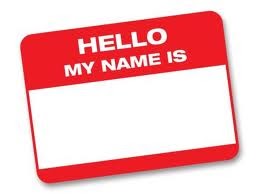What’s in a name? Not much, according to Shakespeare, who waxed lyrical about the label attaching to a woody perennial of the genus Rosa being less important than the object itself.
 Others take the opposing view: according to Logan Persall Smith, “Our names are labels, plainly printed on the bottled essence of our past behaviour”. And according to an old Japanese proverb, “Tigers die and leave their skins; people die and leave their names.”
Others take the opposing view: according to Logan Persall Smith, “Our names are labels, plainly printed on the bottled essence of our past behaviour”. And according to an old Japanese proverb, “Tigers die and leave their skins; people die and leave their names.”
So which is correct? Well, according to a paper presented in Australia
The paper in question was the culmination of research by Dr Deborah Dempsey and Lara Hulbert Mainka (both of Swinburne University of Technology), and Dr Jo Lindsay (Monash University Institute of Family Studies
According to an article in The Age on the study, the results suggest that in many quarters old-fashioned and patriarchal views prevail: women tend change their family name to that of their husband; children tend to take their father’s family name.
The researchers’ conclusions were drawn from a mixed-method study of three data sources:
1. records obtained from the Victorian Registry of Births, Deaths and Marriages between 2005 and 2010;
2. the results of an anonymous online survey of 908 Australian participants, and
3. in-depth telephone interviews with approximately 45 survey participants.
Their study revealed the following trends for families in the State of Victoria
· men in a relationship rarely changed their family name – 97% of those sampled had retained theirs;
· women were far more likely to change their family name and, when they did, generally assumed their partners’.
More than half of the married women in the sample group had changed their family name. Of those, 96% had taken their husband’s family name;
· what was the norm in the family name stakes depended on the relationship: it was normative for married heterosexual couples to have the same family name.
However, it was normative for same-sex couples to have different surnames.
Interviewed on her findings, Dr Dempsey anticipated that the overall proportion of women who had assumed their husbands’ family name might be significantly higher than results suggested – somewhere in the region of 80% to 95%. This was because her sample group had been highly educated. Similar research conducted in the US and Norway
When it came to children, 55% of Victorian children had parents with the same family name. According to the research, this was likely to be the father’s in most cases. Most children born to mothers and fathers with different family names took the father’s. In the vicinity of 90% of children with a named father took their father’s family name. Only 3% of children with a named father took their mother’s family name.
Giving children hyphenated or double-barrelled family names was less popular (only 2.4% per cent of children). However, while heterosexual couples were not keen on using these names, same-sex parents had embraced them. It was also more popular for same-sex couples to create an altogether new family name.
Said Dr Dempsey: “There is still a really strong convention of children taking their father's surnames. When couples have different surnames there is some degree of discussion and negotiation about that, but they tend to resolve it in favour of using the father's surname, and this, to me, is one of the most interesting aspects of the findings so far.”
The Age also featured an interview with one mother, Nadia Di Blasi. She had kept her family name when she married, viewing taking her husband’s as “clearly inherently sexist”. When their son was born, she assumed a similarly progressive view might prevail.
Ms Di Blasi recalls the family name issue as a source of angst in the lead-up to their son’s birth. ''I wanted [him] to have my surname … It seemed so unfair that I would be erased from his identity.'' But after the baby was born, feelings shifted and she chose her husband's family name over a double-barrelled one for the child.
''I was surprised at how visceral the bond I had with him was, and it ameliorated any fear I had that my connection with him might be diminished because he wouldn't share my name.''
Nevertheless, she described a lingering feeling of having ''caved'' on the decision. ''I imagine that every couple that has the discussion but then goes with the paternal surname would have an excuse of some kind to justify their decision. But maybe it comes down to not being brave enough to go against the tide.''
A full results summary from the Victorian study will be published shortly on the project website.
Bishop & Sewell LLP is hosting an online survey to gauge whether the results from the Victorian study are indicative of the approach to choosing family names in modern British life. The survey can be accessed here, and the results will be published on the Bishop & Sewell website at a future date.



No comments:
Post a Comment